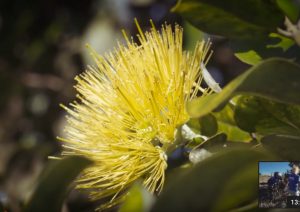New Short Film Highlights Rapid ʻŌhiʻa Death

Five species of ʻōhiʻa are endemic to Hawai‘i, one of which, Metrosideros polymorpha, is the most abundant native species in Hawai‘i, making up 80 percent of native forests. Photo from the film, “The ʻŌhiʻa, the Story of Hawaiʻi’s Tree.”
Hawaiian Airlines is airing a special short film presented by Kupu, “The ʻŌhiʻa, the Story of Hawaiʻi’s Tree,” as part of its in-flight programming from April through July.
The video sheds light on the cultural and environmental significance of ʻōhiʻa and the impact of Rapid ‘Ōhiʻa Death (ROD).
ROD is a disease caused by the fungus Ceratocystis Fimbriata. It has wiped out ʻōhiʻa trees across 50,000 acres on Hawai‘i Island since its discovery in 2014.
“This video project presented an opportunity not only to address a major conservation issue, but also share the important work that is being done by our partners, program participants and the community on Hawai‘i Island,” said John Leong, Kupu CEO. “We need to continue to work together to increase awareness about these types of issues, while empowering the next generation of environmental stewards and leaders who will continue to protect our environment and develop more resilient and sustainable communities in Hawai‘i.
Kupu–Hawai‘i’s leading conservation and youth education organization–the USDA Forest Service and Hālau ʻŌhiʻa – Hawaiʻi Stewardship Training program on Hawai‘i Island partnered to create the film.
It features personal stories from scientists, conservations, kumu hula, dancers and families on Hawai‘i Island who share a mutual commitment and aloha spirit for ʻōhiʻa. Their words bring to light the vital role the tree plays in the environment, Hawaiian culture and community.
Featured speakers include: USDA Forest Service Research Ecologists Christian Giardina and Flint Hughes, and Natural Resource Specialist Kainana Francisco; USDA Agricultural Research Service Plant Pathologist Lisa Keith; Hālau ‘Ōhiʻa – Hawaiʻi Stewardship Training Founder and Trainer Kekuhi Keali‘ikanaka‘oleohaililani; Kupu Interns Ardena Saarinen and Kawehi Lopez, and Program Coordinator Malia Heimuli; and Lahela Camara and her daughter Hāwelelani.
“As a destination carrier, we strive to provide our guests with warm hospitality and unique in-flight offerings,” said Renee Awana, senior manager of product development at Hawaiian Airlines. “As part of that, we also understand the importance of educating visitors about our pristine and fragile island habitat. Together with Kupu, we believe this film will shine a light on an important issue that all travelers should be aware of.”
ʻŌhiʻa trees are endemic to Hawai‘i and considered to be one of the most significant plants in the Islands. They are one of the first to grow after a lava flow, and play a crucial role in developing soil and forming new ecosystems. ʻŌhiʻa provide critical habitats for many native species, and also play a prominent role in Hawaiian culture through moʻolelo (stories), mele (song), ʻoli (chant) and hula (dance).
“ʻŌhiʻa is as old as the volcanic islands,” said Kekuhi Kealiʻikanakaʻoleohaililani of Hālau ʻŌhiʻa. “When we talk about their significance, we may talk about objects of the culture. But, what we need to begin talking about seriously, is if the ʻōhiʻa were not here, what about our lifeway might change.”
“It’s impossible for me to imagine a Hawaiʻi without ʻōhiʻa,” said Kainana Francisco of the USDA Forest Service. “Losing ʻōhiʻa would have devastating ripple effects on our forest landscapes and watersheds, the health of our islands and our communities, and Hawaiʻi culture and lifeways. So it’s important for everyone, Hawai‘i stewardship agencies and organizations, our communities, and even our visitors to our islands, to continue to work together to prevent the disease from spreading, and protect Hawai‘i’s precious natural resources and unique ecosystems.”
ROD is currently isolated to Hawai‘i Island, but it has the potential to spread to other islands and affect ecosystems statewide. Here are some simple ways to prevent the spread of ROD:
- Not moving any parts of the ʻōhiʻa plant
- Not transporting ʻōhiʻa interisland per the State Department of Agriculture’s quarantine rule preventing ROD from reaching other islands
- Avoid wounding or pruning ʻōhiʻa plants, which make them vulnerable to the fungus
- Decontaminate gear and tools (including shoes and clothes) before and after entering forests
- Wash tires and undercarriages of vehicles when traveling off-road and to any areas affected by ROD
For more information about ʻōhiʻa, ROD, and other updates on the work that needs to be done about ROD, visit www.rapidohiadeath.org.












